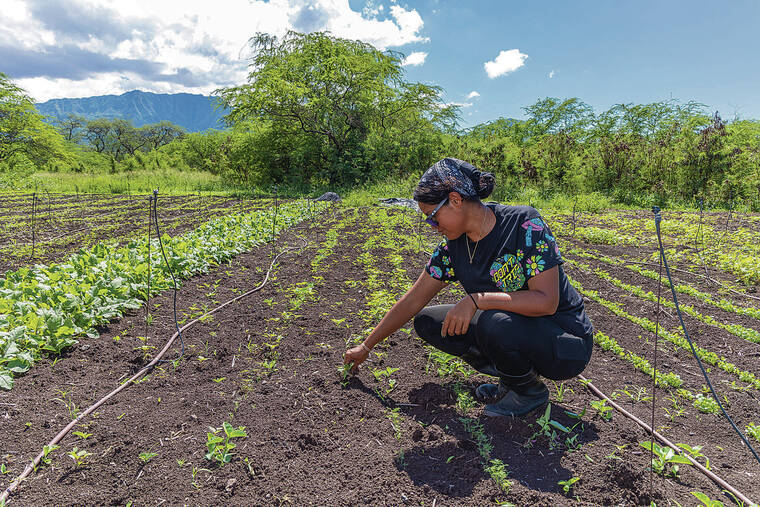
Mahalo for supporting Honolulu Star-Advertiser. Enjoy this free story!
A host of bills moving through the state Legislature represent the latest effort in an ongoing movement to bring healthier, locally sourced meals to Hawaii’s public schools.
So far the measures have received waves of support — except from the state’s public school system.
Under Act 175, which became law in 2021, the state Department of Education is required by 2030 to locally source 30% of the food it serves at Hawaii’s public schools, and to implement what’s known as the Farm to School program to improve the health of the state’s children while supporting local farmers.
This year state lawmakers, supporters of farming and anti-hunger advocates hope to expedite Farm to School, centering their efforts around House Bills 247, 248, 249 and 250 — all co-introduced by Rep. Amy Perruso (D, Wahiawa-Whitmore Village-Mokuleia).
“The idea behind this suite of bills is to provide the department with the support they need,” Perruso said in an interview with the Honolulu Star-Advertiser.
“The intent is to get more local, fresh, healthy, nutritional food on our kids’ plates,” said Perruso.
The bills aim to tackle a swath of problems with Farm to School, and would include increasing the percentage of local food that the DOE has to purchase; decentralizing the Farm to School program to give complex-area superintendents more control over it; separating the Hawaii Child Nutrition Programs Agency from the DOE and giving the agency more of the Farm to School workload; and incorporating a federal “geographic preference” for food procurement within the DOE.
The first two annual Farm to School reports by the DOE to the state Legislature didn’t show much progress made in the program since its launch.
The department was rebuked for submitting a vague, two-page report to lawmakers prior to the 2022 session with no data on the program or a plan going forward. This year the department submitted a three-page report to the state Legislature that was viewed as a marginal improvement but was still light on details about how the DOE will reach its mandated “30 by 30” goal.
This year’s report did note that 6.2% of the department’s purchased food was locally sourced in 2022. It also listed a lack of consistent supply of locally grown food, the cost of that food, and inadequate cafeteria staff training as challenges to the Farm to School program.
Some of the reporting issues could be alleviated under HB 247, which would, in part, expand reporting requirements of the DOE and other state departments with local food procurement goals. It also establishes a farm-to-state liaison in the governor’s office to “facilitate with reporting requirements and procurement of locally grown food.”
The DOE has been resistant to the proposed decentralization of school kitchens that the Farm to School program and the bills going through the state Legislature this year would bring.
Instead, the department has been committed to building centralized kitchens to feed students, although it hasn’t provided much clarity to lawmakers about how its own plans will provide healthier, locally produced food to students.
Randall Tanaka, assistant superintendent for DOE’s Office of Facilities and Operations and lead for the Farm to School program, said Thursday during a House Committee on Finance hearing on HB 248 that it will take 2-1/2 years to finish a $35 million-$40 million centralized kitchen in Wahiawa. Tanaka hasn’t, however, offered a clear picture of how the kitchen will help the DOE reach its Act 175 goals.
Lawmakers and advocates alike have said that a lack of communication about what the DOE is doing or what it needs is preventing them from assisting.
Perruso, in a House Committee on Education hearing for HB 248 on Feb. 9, said she has never received a plan from Tanaka about the centralized kitchens and the DOE’s Farm to School plan and was “pleading” with him to provide one.
“There are so many really dedicated advocates working on this issue. They’re just waiting to support your work, but it’s a mystery as to the direction that you’re headed,” Perruso told him.
In her interview with the Star-Advertiser on Saturday, Perruso said she had yet to receive a plan from the DOE.
The DOE, in a response to the Star-Advertiser, did not provide a plan about its centralized kitchens, saying in an email that “the centralized kitchen concept is only in the early planning stages, so there are no construction timetables yet.”
Act 175 also established within the DOE a Farm to School coordinator — an employee dedicated to facilitating the program. Tanaka said he hasn’t filled that position since it was established in 2021 because the department still needs to rework the job description.
“We’re redefining what that role is. My goal is to have that person as the food buyer,” Tanaka said Thursday during a House Committee on Finance hearing for HB 248.
But the stall in hiring has been problematic, and HB 249 would attempt to address that by establishing Farm to School positions and moving some of the program work within the Hawaii Child Nutrition Programs Agency and away from the DOE.
Testimony for the bills through the first five weeks of the session have been largely supportive. Hundreds of pages of written testimony, from advocates of anti-hunger policies to farming organizations to health-focused groups, show they want the measures to move forward.
The general belief is that they would be good for students and give small farms in Hawaii an opportunity to sell their fruit and vegetables to individual DOE schools. The department as a whole serves more than 100,000 meals per day and is sometimes referred to as the state’s biggest restaurant.
The DOE’s centralized kitchen plan would favor Hawaii’s biggest farms because centralization works better with growers of large quantities of produce, opponents say.
“The central kitchens don’t preclude us from reaching the goal of 30% — they kind of emphasize a different way of doing it,” said Dennis Chase, program manager of the Hawaii Farm to School Hui. “The biggest farms in the state will get those contracts. … Other farms, even if they have the desire or they want to be involved, there’s a lot of infrastructure they would need before they can do that.”
The DOE has expressed concern over the proposed measures.
For HB 248, it said in written testimony that decentralizing the Farm to School program would be burdensome to complex-area superintendents, and for HB 249 it said the concern is about unforeseen impacts to federal funding that could come from moving the Hawaii Child Nutrition Programs Agency away from the DOE.
It is also said that purchasing from the smallest farms in Hawaii would be more expensive and would prove a challenge when it comes to food safety requirements.
Tanaka said small, local farms are also difficult to rely on when it comes to consistently providing large quantities of produce to individual schools, an argument the DOE made against both HB 247 and 249.
“That’s why we’re working on the centralized kitchen,” Tanaka told lawmakers at Thursday’s hearing on HB 248. “Independent purchasing does not give us the consistency of purchasing across the board.”
But advocates say the DOE needs to provide a list of needs first, and farmers can scale up from there.
Hawaii Farm Bureau’s Executive Director Brian Miyamoto, during the hearing, said, “We want to know what the DOE would like our farmers to grow so they can scale up, so they can plan.”
Matt Johnson, CEO of the Oahu Fresh Food Hub, said approved contracts for food need to be in place before farmers will be interested. Otherwise it’s too risky for them.
“Farms have to put all the investment upfront — they have to buy the seeds, they have to prepare the land — so all the liability is on the farm,” he told the Star-Advertiser.
Other Farm to School advocates have refuted the DOE’s argument that local farmers can’t supply enough fruit and vegetables to meet its needs, saying instead that local farmers are producing more than enough.
Perruso said the future of the DOE’s Farm to School program doesn’t have to consist of strictly decentralized or centralized kitchens, but it needs to be decided using good policies, transparency and evidence-based approaches.
HB 248 and 250 were heard and passed the House Committee on Finance last week. HB 247 and 249 have been scheduled for a Thursday hearing by the committee, which they need to pass through this week in order to continue on.
Read More: World News | Entertainment News | Celeb News
Star Ads





